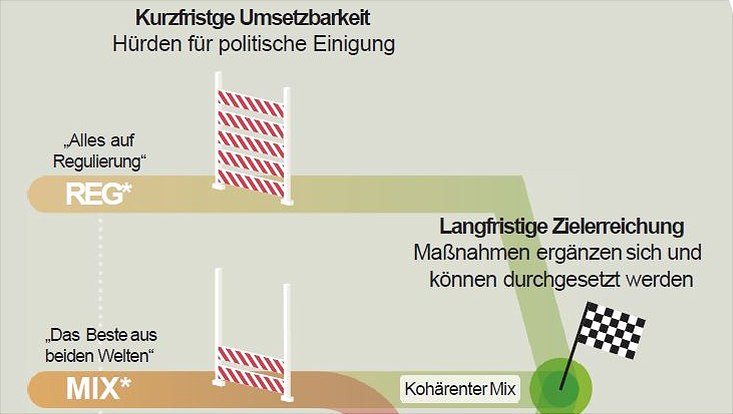Expert assessment: The path of least resistance will miss the climate targetHidden risks and opportunities of the EU scenarios for a 55% climate target 2030
9 December 2020, by Potsdam Institut für Klimafolgenforschung (PIK)

Photo: Ariadne Projekt
An EU decision this week to ramp up the climate target for 2030 will be about more than the mere willingness to make greater political efforts towards climate neutrality in 2050. The target also shapes German climate policy. Experts from the Kopernikus energy transition project Ariadne, funded by the German Federal Ministry of Education and Research, scrutinized the EU Commission's most important scenarios for more ambitious measures. Should the EU continue to rely on a varied mix of instruments lacking a clear concept for their interactions, it runs the risk of failing to meet its new goals, their research shows.
The EU Commission put three main scenarios with a chance of achieving the 55% EU climate target for 2030 up for debate: To meet more ambitious climate targets, the EU could either strengthen regulatory measures as a priority, in particular by strongly intensifying renewable energy and energy efficiency policies. It could also make CO2 pricing the key instrument by introducing emissions trading in the transport and buildings sectors and for smaller industrial plants. Or it could move forward with the existing policy mix, in which regulatory measures are strengthened while the existing emissions trading for large energy and industrial installations is either extended to include more individual sectors, or a second and new emissions trading scheme is set up in parallel. The researchers now examined these policy paths for two decisive factors: the short-term feasibility and the long-term likelihood of meeting the climate target.

"Focus on regulation" or "Focus on CO2 pricing"?
In the regulatory scenario, the EU would step up its action on energy efficiency and renewable energy. "This path can cause deep interventions in national energy structures. If Member States have reservations, the EU will not have the legal competence to adopt these measures" political scientist and Professor Michèle Knodt from the Technical University of Darmstadt, member of the Ariadne Consortium and Director of the Jean Monnet Centre of Excellence "EU in Global Dialogue", explains. This scenario offers a high probability of meeting the targets in the long term: "The regulatory scenario can function as a coherent legislative package through the key instrument of an EU-wide tightening of targets and measures for renewable energies and energy efficiency. A prerequisite, however, is that the existing enforcement mechanisms of the EU Commission towards the Member States, such as sanction mechanisms, are tightened as well."
In the EU Commission's carbon pricing based scenario, the CO2 price would become the key instrument, for example by strongly expanding emissions trading with the new sectors shipping (intra-EU), buildings and transport. This path is challenging because politicians and ultimately industry must be prepared to accept very high CO2 prices if necessary. "However, these barriers could be overcome by a fair and socially just CO2 pricing concept. If the EU were prepared to accept high CO2 prices taking this into account, a uniform CO2 price across all Member States and sectors would be convincing as a coherent, cost-efficient key instrument with a high degree of credibility in meeting the target", climate economist and Professor Ottmar Edenhofer, Head of the Ariadne project and Director of the Potsdam Institute for Climate Impact Research and the Mercator Research Institute on Global Commons and Climate Change, says.
Rather continue on the middle road? The usual policy mix runs the risk of missing its target
"As a middle course, a change in the familiar mix of policy instruments appears to be the most easily enforceable path in the EU in the short term. But this path of least resistance could entail risks in the long term," lawyer and Professor Sabine Schlacke of the University of Münster, member of the Ariadne consortium, explains. A policy mix scenario will only work if the partly overlapping and possibly also contradictory instruments and enforcement mechanisms for meeting the climate targets are coordinated. "If these inconsistencies are not addressed and incorporated into the EU policy package, a mix will not ultimately offer the best of two policy worlds. On the contrary, due to measures impeding one another, it will fail to meet the climate target altogether", Schlacke sums up.
A credible policy mix should therefore be based on a clear regulatory principle and be accompanied by instruments aligned with the climate targets, according to the experts of the Kopernikus project Ariadne. This could be along the lines of a key instrument for emissions reductions such as CO2 pricing, with accompanying regulatory instruments that specifically address unrecognized obstacles such as the accelerated expansion of infrastructure. Finally, a policy mix should also be equipped with a continuous adjustment mechanism that regularly reviews and further develops the fulfilment of targets and adapts to changing framework conditions, for example through an independent scientific advisory board. The experts conclude that this should be taken into account urgently in the EU Commissions proposals for a reform of the regulatory framework that is expected next year. Otherwise, they warn, the path just taken up with the European Green Deal could already be lost on the first few metres.
Further Information
Find the Ariadne Dossier here (in German)
Media contact
Prof. Dr. Grischa Perino
Universität Hamburg
Fakultät für Wirtschafts- und Sozialwissenschaften
Welckerstraße 8
20354 Hamburg
Raum: 5.12
Tel.: +49 40 42838 8767
E-Mail: grischa.perino"AT"uni-hamburg.de
Stephanie Janssen
CEN/CLICCS-Office
Universität Hamburg
Bundesstrasse 53
20146 Hamburg
Raum: 016
Tel.: +49 40 42838 7596
E-Mail: stephanie.janssen"AT"uni-hamburg.de


